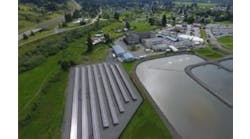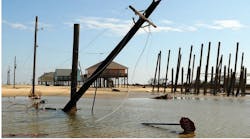A new special report from Microgrid Knowledge and Schneider Electric outlines the energy-as-a-service (EaaS) model and explains how it simplifies development and ownership of microgrids. This chapter focuses on trends that led to the rise of microgrids.
Download the full report.
Until recently, the electric power industry saw little in the way of major innovation. For more than a century, the industry produced and delivered power in much the same way — generating electricity at central plants and sending it through miles of wires to homes and businesses. Customers became accustomed to the system and thought little about who created their power — or how it was produced. Alternatives were scarce, if they existed at all, so they just paid the bill each month, acting as passive recipients.
But now the energy landscape is transforming. Customers have choices as electric supply diversifies. New opportunities allow them to secure energy from cleaner sources in a way that better suits their needs— and saves them money. By bringing power production on site, businesses access economic, environmental and reliability benefits unavailable to them under the old electricity business model. They are the new prosumers in charge of their energy destiny.
So how did we get here? What’s driving the change? It can be summed up in the phrase, “More E and three D,” an encapsulation of four transformative trends changing energy decision-making:
- Growing demand for electricity
- Digitize
- Decarbonize
- Decentralize
It’s important to understand these trends because they underscore why businesses need to think about their energy use more closely. Good energy management is no longer a nice-to-do but is a need-to-do. Change is happening rapidly in energy, and those who ignore it may find they’ve left money on the table.
Trends bolstering energy-as-a-service microgrids
Growing demand for electricity
We are becoming an increasingly electrified society. Telecommunications, refrigeration, industrial motors, computers, advanced medical care and other staples of modern life all require power. As a result, worldwide demand for electricity is growing faster than for any other form of energy.
Various factors drive the growth, among them the need to bring power to one billion people in Africa, Asia and India that still lack electricity and the transition from gas-combustion to electric vehicles.
Government and industry are trying to decarbonize; doing so requires finding more efficient ways to produce and use energy. (Photo by petrmalinak/Shutterstock
Digitize
Meanwhile, society also is becoming more digitized, relying on the Internet and computer-related services to function on almost all levels—households, business operations, food and water management, transportation and communication, and government and military.
To get a sense of the pace of digitization, consider the massive flow of information across the Internet as we add more and more devices, creating an Internet of Things (IoT). Cisco finds that mobile data traffic alone will grow at a compound annual growth rate of 47 percent from 2016 to 2021. This increase comes as the number of cell phone owners grows—more people are expected to own cell phones than have access to running water or even electricity by 2020.
Energy IoT opens the door for better understanding of our energy use.
Sensors can discern energy use down to individual pieces of equipment. Digital energy displays make clear how much energy is being used, and when and where within a building. Smart thermostats and controls ensure that lights, heating and cooling match room use.
“Data demystifies energy,” said Mark Feasel, vice president electric utility segment and smart grid at Schneider Electric. “Digitizing energy infrastructure can unlock better resilience and sustainability, and more predictable costs. Through our project development process, we quantify the value of these improvements to the consumer and then design a solution to achieve agreed upon outcomes.”
Fortunately, the next two trends we will discuss — decarbonization and decentralization — help shape an electric supply that can meet the demands of an increasingly electrified and digitized society.
Decarbonize
By Bevan Von Weichardt/Shutterstock
The conventional electric grid produces high levels of carbon dioxide. Electricity is responsible for over one-third of the carbon produced by the US energy sector. Government and industry are trying to decarbonize; doing so requires finding more efficient ways to produce and use energy.
“Data demystifies energy. Digitizing energy infrastructure can unlock better resilience and sustainability, and more predictable costs.” – Mark Feasel, Schneider Electric
Here’s where we see the flip side of digitization. While it demands more use of electricity, digitization also creates new streamlined ways to manage energy. Today’s building automation systems and microgrid controllers are products of advanced digitization.
- Building automation systems avoid energy waste by controlling a building’s lighting, heating, ventilation and air conditioning in a centralized way.
- A microgrid controller acts as a microgrid’s brain, allowing it to island seamlessly away from the central grid during a power outage and then back again when the central grid re-energizes. Controllers also assist in managing on-site and off-site supply. This improves operational efficiency.
These technologies will play an important role in helping industry decarbonize, a worldwide effort now embraced by more than 420 major corporations. The companies have committed to science-based goals to cut greenhouse gas emissions. More than three quarters say their environmental efforts enhance brand reputation, and a third cite cost-savings, according to a survey by the Science Based Targets initiative. Those surveyed listed the environment as a chief influence on business growth, even higher than economic policy.
The fourth trend—decentralization—brings even greater sophistication to energy management and adds the benefits of reliability and resiliency.
Society is becoming more digitized, relying on the Internet and computer-related services to function on almost all levels—households, business operations, food and water management, transportation and communication, and government and military.(Photo: Shutterstock)
Decentralize
The conventional power model — what Pittsburgh’s mayor William Peduto describes as making your toast from electricity produced at a power plant 100 miles away — is giving way to a new decentralized approach. This is made possible by the proliferation of onsite power — smaller, often renewable, generation systems that can be placed on, or near, the buildings they serve.
Distributed energy is efficient because it averts what is known in the power industry as line loss. When power travels over transmission and distribution lines a significant portion dissipates as heat along the journey, as much as 15 percent. That’s power produced, and emissions created, for no good purpose. It’s money evaporated. So it’s ability to avert line loss, alone, makes distributed energy a preferable alternative.
In addition, digitization allows for increasingly pinpointed decentralization, tailored to the unique needs of an operation. Using data, energy analysts can characterize exactly what part of a business most needs reliable energy and tailor the installation accordingly.
“We no longer necessarily install one big microgrid; instead we may build a federation of microgrids for a facility, tied together at the Cloud level. That drastically reduces the cost of building a microgrid.” – Philip Barton, Schneider Electric
“Ten years ago, a microgrid tended to be designed for the whole building. Today we are more prescriptive. We build microgrids to serve specific loads within the facility that are sensitive to outages,” said Philip Barton. “So, we no longer necessarily install one big microgrid; instead we may build a federation of microgrids for a facility, tied together at the Cloud level. That drastically reduces the cost of building a microgrid.”
Opening the way for microgrids
For energy decision-makers these four trends — energy demand, digitization, decarbonization and decentralization — have opened the way for less expensive, cleaner, more reliable energy supply tailored to a facility’s unique needs. So why don’t more businesses, institutions and communities have microgrids? We’ll get into that in the next chapter which explores microgrid drivers and obstructions.
The special report series on energy-as-a-service microgrids will also cover the following topics in the coming weeks:
- Securing Microgrid Benefits Without the Risk
- Understanding the Energy-as-a-Service Model for Microgrids
- Energy-as-a-Service Microgrids in the Real World
For more on Energy-as-a-Service Model microgrids, see the full special report, “The Financial Decision-Makers Guide to Energy-as-a-Service Microgrids,” courtesy of Schneider Elexctric, downloadable free of charge.







